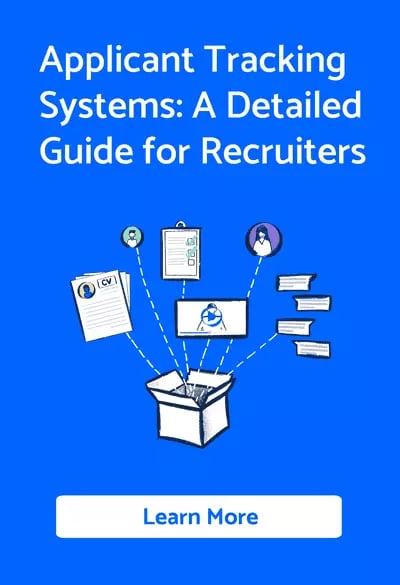Did you know that according to a recent study, companies that use applicant tracking systems experience a 75% reduction in time-to-hire? Sounds like the most exciting thing in the world, right? Trust us when we say that - it's a game-changer for your business.
Application tracking system integration improves recruiter efficiency as it can save you time, money, and headaches by streamlining the entire recruitment process. But that's not all! ATS integration also provides powerful data and analytics that can help you make informed hiring decisions and build stronger relationships with top talent. Undoubtedly, your team can focus on what really matters: finding the best talent to drive your business forward.
Whether you're a seasoned pro or new to the recruitment game, get ready to dive into the applicant tracking system integration world and discover how it can take your recruitment efforts to the next level!
Importance of ATS for Recruiters
An applicant tracking system (ATS) empowers recruiters to navigate the fast-paced hiring landscape. Some of the most important benefits are:
- Sorting through the overwhelming number of resumes received can be a tedious and time-consuming task for recruiters. With application tracking system integration, screening resumes can be automated, saving recruiters a lot of time and ensuring that every resume is given a fair chance.
- ATS integration enables recruiters to keep candidate information in one centralised location, reducing the need to shuffle through various platforms and paperwork.
- 3. Collaborating with team members and hiring managers is also made easier with ATS integration, ensuring everyone involved in the hiring process is aligned and informed.
- Data and recruitment analytics provided by ATS offer valuable insights into the recruitment process, enabling recruiters to make informed decisions that can lead to better hiring outcomes.
- As more recruiters adopt this technology, it is clear that applicant tracking system requirements are high, improving recruiter efficiency and revolutionising the recruitment process seamlessly.
Understanding ATS Integration
Are you struggling to keep up with the demands of the hiring process and feeling like you're drowning in a sea of resumes? Applicant tracking system (ATS) integration is the revolutionary tool you've been looking for. But what exactly is ATS integration, and how can it transform your recruitment efforts? Let's dive in and explore its benefits and types.
Benefits of integrating ATS with other HR systems
Juggling between multiple HR systems and keeping track of candidate information can be extremely troublesome. It's time to consider the power of integrating your applicant tracking system (ATS) with other HR systems.
If you’re still wondering why recruiters should use applicant tracking system, here are just a few of the jaw-dropping benefits you'll experience when you take the plunge and integrate your ATS:
- Efficient process: Say goodbye to manual data entry and the headache of managing multiple platforms. With ATS integration, you can streamline your hiring process, reduce errors, and ensure that all candidate information is accurate and up-to-date.
- Enhanced candidate experience: Integrating your ATS with other HR systems can lead to a seamless candidate experience. From application to onboarding, candidates will appreciate the ease of use and professionalism of your recruitment process.
- Improved collaboration: Integrating your ATS with other HR systems can promote collaboration between team members and hiring managers. This increased transparency and communication can lead to better outcomes and more efficient hiring.
- Cost savings: By reducing manual processes and streamlining your recruitment efforts, application tracking system integration can lead to significant cost savings over time.
Wait no more and take your recruitment process to the next level. The benefits of integrating your ATS with other HR systems are clear. But wait, there's more! Let's now explore some additional ways that ATS integration can help improve recruiter efficiency.
Improving Recruiter Efficiency with ATS Integration
Recruiting is a critical aspect of any organisation's success, but it can also be time-consuming and resource-intensive. This is where ATS integrations come in, offering a range of tools and features that can improve recruiter efficiency and streamline the hiring process.
Companies nowadays leverage multiple applicant tracking system requirements - from automated resume screening to scheduling and communication with candidates, ATS integrations enable recruiters to focus on what really matters - finding and hiring the best talent. Let's take a closer look:
- Streamlining the job posting process: ATS integrations revolutionise the way recruiters post job openings by enabling them to automate the process and save time. By leveraging the power of technology, recruiters can post job ads on multiple platforms with just a few clicks, increasing visibility and reach. This frees up recruiters to focus on the more strategic aspects of recruitment, such as candidate engagement and talent acquisition.
- Automating resume screening and ranking: Application tracking system integrations offer recruiters the ability to automate and streamline the often time-consuming process of resume screening and ranking. By leveraging AI-powered algorithms, ATS integrations can analyse resumes and rank them based on their relevance to the job opening. This ensures that recruiters spend more time engaging with the most qualified candidates, leading to faster and more effective hiring.
- Scheduling and communication with candidates: By automating interview scheduling and sending reminders, ATS integrations can reduce administrative burden and improve candidate experience. Additionally, by centralising communication channels, recruiters can easily keep track of candidate interactions, leading to better coordination and faster decision-making.
- Enhancing data analysis and reporting capabilities: Application tracking system integrations bring an added layer of sophistication to recruitment processes, offering recruiters advanced data analysis and reporting capabilities. With key recruitment metrics and insights, recruiters can make data-driven decisions that optimise their hiring strategies and improve candidate engagement. This yields better outcomes for both candidates and employers.
It’s clear from the above points that with ATS integrations, recruiters can unlock a whole new level of efficiency and effectiveness in their hiring processes. But, there are still challenges that recruiters must navigate to realise the benefits of these tools fully. In the next section, we will explore some of the common challenges that recruiters face with ATS integrations and offer strategies for overcoming them.
Challenges and Considerations for ATS Integration
Recruiting can be daunting, and many recruiters turn to Applicant Tracking Systems (ATS) integrations to help streamline their recruitment process. While ATS can be incredibly helpful, integrating these systems can also present a unique set of challenges. Let’s delve deeper!
Potential challenges and tips for overcoming these challenges
1. Integration with existing systems: One of the biggest challenges recruiters face is integrating the ATS with their existing HR and recruitment systems. This can lead to data transfer, synchronisation, and potential compatibility issues between the different systems.
# Tip: Before implementing an ATS, it is important to assess your existing systems and identify any potential compatibility issues. It may be necessary to make updates or modifications to your systems to ensure seamless integration with the new ATS. Working closely with the ATS vendor and your IT team can also help to ensure a successful integration.
2. Data accuracy and completeness: Another challenge with ATS Resume integrations is ensuring data accuracy and completeness. This is particularly important when it comes to resume screening and ranking, as inaccurate or incomplete data can lead to missed opportunities and poor candidate experience.
# Tip: To ensure accurate and complete data, it is important to establish clear data entry guidelines and protocols for recruiters and hiring managers. This can include standardising resume formatting and requiring specific information from candidates. Regular data audits can also help identify and correct any data accuracy and completeness issues, providing the correct recruitment metrics in the long run.
3. Candidate experience: Finally, a potential challenge with ATS integrations is maintaining a positive candidate experience. Automated systems can sometimes feel impersonal or leave candidates feeling like their applications are getting lost.
#Tip: To overcome this challenge, it is important to balance automation and personalisation. This can include incorporating personalised communication and follow-up messages into the recruitment process and providing candidates with clear instructions on navigating the ATS. Regularly seeking candidate feedback can also help identify improvement areas in the recruitment process.
By proactively addressing these challenges, recruiters can optimise the benefits of ATS integrations and enhance their recruitment strategies.
Factors to consider before implementing ATS integration
Implementing an ATS can significantly benefit recruiters, but it's essential to consider a range of factors before integrating a system into your recruitment process. In this section, we've explored some of the less commonly discussed factors to consider before implementing an ATS. This can help recruiters ensure that they select an ATS that is aligned with their unique recruitment needs.
- Data privacy and security: It's essential to consider how the system handles sensitive candidate data and ensure that it adheres to industry standards for data privacy and security. This includes assessing the ATS provider's security protocols and ensuring the system complies with relevant regulations such as GDPR and CCPA.
- Customisability and flexibility: While many ATS integrations offer pre-configured workflows, it's essential to consider how customisable the system is and whether it can be tailored to fit your unique recruitment needs. A highly customisable ATS can help optimise your recruitment process and improve your candidate experience.
- User experience and adoption: Before selecting an ATS, consider the user experience of both recruiters and candidates. Look for an ATS that is user-friendly, intuitive, and easy to navigate. Additionally, ensure that the system offers thorough training and support to ensure smooth adoption by recruiters and hiring managers.
- Scalability and cost: Your recruitment needs will evolve as your company grows. It's essential to consider how scalable the ATS is and whether it can grow with your company. Additionally, factor in the cost of the system and ensure that the ROI is significant and that the cost doesn't outweigh the benefits.
It's crucial to take a holistic approach when implementing a new system. By carefully considering the unique factors discussed in this section, recruiters can select the right ATS and implement it seamlessly.
Final note
Well, that's a wrap, folks! We've dug deep into ATS integration and how it can revolutionise a recruiter's hiring game. With automated resume screening, streamlined job postings, and enhanced candidate communication, recruiters can finally take a breather and focus on what they do best - hiring top talent.
So, what are you waiting for? It's time to say goodbye to manual recruitment and embrace the power of ATS integration. Trust us; it's the icing on the cake that you never knew you needed!





